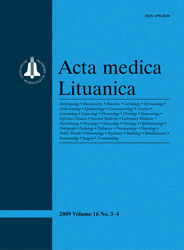Acta medica Lituanica
 ISSN 1392-0138 ISSN 2029-4174 (online) |
2011 m. Nr. 4 Diffusion-weighted magnetic resonance imaging of cervical cancer
Background. Diffusion-weighted magnetic resonance imaging (DW–MRI) has been employed in the diagnostics of malignant tumors of abdomen and pelvis relatively recently. Nowadays, there exists a particular interest in adaptation DW–MRI for assessing the response of tumors to chemoradiaton therapy. The aim of our study was to compare the mean value of the apparent diffusion coefficient (ADC) in a healthy cervix, cancer-affected cervix and a cervix after chemoradiation therapy, as well as to identify the ADC range typical of cervical cancer.
Materials and methods. The study enrolled 108 female patients who underwent pelvic MRI in the Lithuanian University of Health Sciences Kaunas Clinics Hospital in 2008–2010. The study group consisted of 65 patients in whom cervical cancer had been clinically suspected and confirmed by biopsy before MRI examination. All these patients underwent pelvic MRI twice: before the chemoradiation therapy and 6 months after the therapy. The control group consisted of 43 patients in whom cervical cancer had been not suspected and MRI was performed because of other pelvic diseases. Results. The mean ADC value of the study group (0.658 ± 0.118 × 10–3 mm2/s) was lower than of the control group (1.171 ± 0.143 × 10–3 mm2/s) (t = 20.315, p = 0.03). The ADC threshold value of 0.945 × 10–3 mm2/s was defined, differentiating the cancer-affected cervical tissue from the normal. The mean ADC value of the patients who responded to chemoradiation therapy (1.111 ± 0.138 × 10–3 mm2/s) increased and in those who did not respond it remained lower (0.733 ± 0.073 × 10–3 mm2/s) (t = 9.518, p = 0.04). The ADC threshold value of 0.830 × 10–3 mm2/s was defined, differentiating the residual tumor tissue from the healthy cervical tissue after chemoradiation therapy. Conclusions. The ADC value in the case of cervical cancer was significantly lower than in the non-affected cervical tissue. The ADC value increases after effective chemoradiation therapy and becomes closer to the coefficient value of non-affected cervical tissue, but still remains lower. The 0.945 × 10–3 mm2/s ADC threshold was detected while differentiating between cancer-affected and normal cervical tissues, while the ADC threshold was 0.830 × 10–3 mm2/s when differentiating between residual tumor tissue and healthy cervical tissue after chemoradiation therapy at a high sensitivity and specificity. Keywords: diffusion-weighted magnetic resonance imaging, apparent diffusion coefficient, cervical cancer, chemoradiation therapy |
Issues:
2011 - Vol.18 No. 1, No. 2, No. 3, No. 4 2010 - Vol.17 No. 1-2, No. 3-4 2009 - Vol.16 No. 1-2, No. 3-4 2008 - Vol.15 No. 1, No. 2, No. 3, No. 4 2007 - Vol.14 No. 1, No. 2, No. 3, No. 4 2006 - Vol.13 No. 1, No. 2, No. 3, No. 4 2005 - Vol.12 No. 1, No. 2, No. 3, No. 4 2004 - Vol.11 No. 1, No. 2, No. 3, No. 4 2003 - Vol.10 No. 1, No. 2, No. 3, No. 4 2002 - Vol.9 No. 1, No. 2, No. 3, No. 4 2001 - Vol.8 No. 1, No. 2, No. 3, No. 4 |